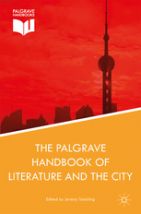The Palgrave Handbook of Literature and the City

This large compendium explores the importance of writings about a city to how cities become embedded in the popular imagination. V.S. Naipaul, for instance, has said, “No city or landscape is truly rich unless it has been given the quality of myth by writer, painter, or by its association with great events.” It’s also been argued that urbanization has been essential to how we view modernization, and has thus inflected modernist literature. As well, an urban setting allows a novelist a rich landscape to set characters of vastly different backgrounds. A perhaps extreme example is Vikram Seth’s epic novel A Suitable Boy, set in Indian cities both real and fictional. And examining the historical trajectory of writing on cities in Africa, Asia and the Americas offers one lens on changing attitudes and effects related to colonialism. Thus, for these and other reasons, viewing urban change and systems through the lens of literature is potentially useful to urban studies.
The handbook abounds with examples of themes and locations. The section on the Hispanic Caribbean discusses how novels about Havana, San Juan and Santo Domingo have reflected preoccupations with unequal development in these cities. Also explored is how crime fiction has depicted cities as hotbeds of dysfunction and violence, from the London of Arthur Conan Doyle to the Los Angeles of James Ellroy.
One chapter explains the importance of journalistic essays for understanding Mexico City, such as Sara Sefchovich’s condemnation of the ineffectual Mexican politics radiating out from the capital, or Carlos Monsiváis provocations exploring how Mexico City’s queer culture challenges “the compulsory heterosexuality of the European project of modernity” mandated by colonizers (page 365).
The overview of the literature on African cities argues that modern African texts about cities are undergirded by a sense, sometimes oppositional, of a rural home. (However, the chapters on India and China make the same argument.) For instance, perhaps the most prominent East African writer, Kenyan Ngũgĩ wa Thiong’o, has written piercingly of the ways that decision-making in Nairobi affects rural communities. To take another example, South African plays shone a light on apartheid-era inequality. But the external response to South African literature, in its privileging of white novelists’ voices, itself shows how certain kinds of South African experiences have been elevated over others.
It would be difficult to give more than a taste of this weighty book. The handbook may be of interest to those who believe that fiction can be as illuminating as nonfiction, and that the way cities have become inscribed in literature shapes and reflects perceptions of these spaces.
Further reading:
García Márquez, Gabriel (1993), “The river of our life”, Environment and Urbanization Vol 5, No 1, pages 162–165, available at http://journals.sagepub.com/doi/pdf/10.1177/095624789300500114.
Book note prepared by Christine Ro
Search the Book notes database
Our Book notes database contains details and summaries of all the publications included in Book notes since 1993 - with details on how to obtain/download.
Use the search form above, or visit the Book notes landing page for more options and latest content.
For a searchable database for papers in Environment and Urbanization, go to http://eau.sagepub.com/

